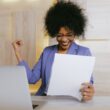SaaS is hot. Really hot. The industry is growing at a tremendous pace, and it’s not showing any signs of slowing down. Just because you’re sitting on a SaaS product with seed funding, doesn’t mean you can disregard the basics of marketing your business. In this post, I will be sharing how to nail your landing page to attract customers.
One of your most important assets when it comes to attracting customers is your product’s landing pages.
The landing page, as the name suggests, is a web page where new visitors enter your site. The goal of a SaaS landing page is to help convert targeted visitors into leads and then hopefully turn those leads into customers.
When creating any kind of landing page, it’s important to remember that the visitor is the most important part of the equation (not the page itself). As a result, the landing page should make it as easy as possible for them to take the actions you want them to take.
While there’s no one-size-fits-all approach to creating a successful SaaS landing page, there are definitely some best practices that you should follow if you want yours to work optimally.
Let’s go over some of the key points to consider when creating a landing page for a SaaS business.
What to Include in Your SaaS Landing Page
Your landing page needs to include several elements such as a headline, images, sales copy, feature descriptions, and a call-to-action.
Obviously, the content of a landing page can’t be prescribed. Every company is unique, every product is different, and every industry has its own requirements in this regard.
If you are having trouble deciding what to include on your site’s landing page, ask yourself these questions:
- What is my value proposition?
- Why would someone care about this product?
- What makes us different from others in our niche?
- Who will benefit the most from our product?
- How can my product solve their problem?
- Why should they trust us?
Also ask yourself whether your landing page would benefit from additional content such as an explainer video, FAQs, or links to technical whitepapers?
If yes, make sure that including these elements doesn’t compromise the primary purpose of your page. Remember that simplicity is key and that your main goal is to urge a visitor towards taking conversion-based action.
For an example of a landing page that’s composed of a ton of “additional” information, look no further than Spores. The company does a terrific job of populating its landing page with a ton of technical information without compromising its accessibility or core message.
Create a Compelling Headline for your SaaS Landing Page
Gone are the days of boring headlines composed of needlessly complicated words and sentences. A good headline should be relevant, simple, clear, and intriguing.
A great headline should do three things:
- Communicate your unique selling points
- Build interest
- Get visitors scrolling down the landing page
It shouldn’t be too long or too short. Keep it under 60 characters. If there is more you want to communicate about your SaaS product, do so further down the landing page. Your headline is too important to dilute with superfluous information.
Mozart Data’s landing page is a terrific example of simplicity and clarity. Within an instant, the reader knows exactly what the company offers and what the benefits of becoming a customer are.
An engaging, meaningful image is also important for a landing page’s headline area. A picture speaks a thousand words, and if there’s anywhere on your landing page where you want to communicate a concept quickly, it’s here.
Don’t just use a stock photo; take some time to create a custom graphic that matches the theme of your business and brand.
Take a look at the excellent header image created by the designers at Xero. When looked at in conjunction with the headline text, the company’s main purpose of making a business owner’s life easier is beautifully illustrated.
Make Your Call to Action Buttons Pop
Always remember that a landing page is set up to get visitors to perform an action on your site.
This could be anything from requesting a quote, signing up for a newsletter, or registering for the product’s trial plan. Regardless of what the purpose of your CTAs is, it’s crucial that they stand out from the rest of the page’s content.
They need to be bold, simple, and have a clear purpose. You want your visitors to hit “sign up” or “get started” as soon as possible. So don’t make them search for these triggers.
Bench keeps it super simple with the CTA in their landing page’s header. The button’s size makes it easy to spot, while the color makes it pop while also complementing the page’s design. More than anything, though, the text label (“Start Free Trial”) is action-focused and contains a descriptor that makes clicking on it a very enticing proposition.
Communicate Your SaaS Product’s Key Features
It’s vital that you use your SaaS landing page to communicate your product’s key features. Prospective customers want to know what your product is all about, why it’s different from existing solutions, and how you can help them.
The key is to communicate your features in a way that shows how you’re solving a specific problem for your customer.
InFlow Inventory nails this approach with a landing page that focuses on one specific problem – disruptions in a supply chain.
Remember that, when talking about product features on a landing page, your goal is to persuade visitors that your SaaS product is a good match for their needs. Always try to map a particular feature to something you know your typical customer struggles with.
Your landing page isn’t the correct place for a full inventory of your software’s features. Highlight three or four of its most important functions and tell your visitors how these will positively impact their lives.
For an example of two landing pages that knock this approach out of the park, look no further than Flamingo and GoCo.
Both of these landing pages shine a spotlight on what the product does while at the same time letting the audience know what these features mean for them.
Manage Expectations Realistically
If there’s one thing that will make people run away from your landing page, it’s blatant over-promising. Making outlandish claims using shady language is one of the quickest ways to kill all trust in your brand.
You want a lead to feel positive emotions about the prospect of doing business with your company, not be overwhelmed with the fear of being duped into signing up for a service that doesn’t deliver on its promises.
Most of us have probably been annoyed by neverending email spam promising life-changing hacks or tips that have no way of living up to their hype. Do everything you can to distance your brand from this kind of marketing ploy.
Keep your promises realistic. Speak in a professional, friendly tone. Treat your customers like you’d want to be treated by a prospective service provider.
More than anything, always ensure that your SaaS landing page clearly presents only what’s factual.
For instance, you probably won’t be able to offer “unlimited storage for free.” Also, you should absolutely avoid using phrases like “no more worries” or “never have to worry about…” because, well, we all know that life involves a lot of worrying, and it would be impossible to eliminate concern entirely from your customers’ lives.
It’s important that you are very clear about the benefits your product does offer rather than exaggerate claims that could set up false expectations. You need your leads to think about your product and brand with enthusiasm, not skepticism.
Amazon repricer, Aura, does a terrific job of positioning their SaaS product using highly emotive language while avoiding the trap of overpromising.
Use Explainer Videos
Explainer videos on your Saas Landing page are a great way to get your visitors’ attention. They’re also fantastic at nurturing interest and boosting conversions.
Like we said before, people are a lot more likely to invest in your product when they know what it can do for them. Having a great explainer video on your landing page is like telling someone about the idea and then showing them how to use it. It’s visual proof of concept.
It also gives you an opportunity to talk about your brand and your products in a highly engaging, entertaining way.
With a well-produced, professional, informative explainer video on your landing page, your potential customers will get a taste of your brand’s personality as well as the finer points of your software itself. Optimal Workshop gives us an amazing example of an explainer video that combines these two goals.
An explainer video can also give you an edge over competitors by making it easy for people to understand how your product works without feeling overwhelmed by technical terms and jargon. It gives them just enough information so they know if this is something they need.
Use Your Landing Page to Create Social Proof
Your landing page is a great place to showcase your business’s credibility.
If you’re trying to generate interest in your SaaS product, it’s incredibly helpful if you can give a voice to your customers. After all, these are the people who have found value in doing business with you.
People trust the opinions of others before they trust your copywriting and sales pitch. So don’t hesitate to publish testimonials on your landing page. Get your customers’ permission and use their actual names, real photos, company affiliations, and even quotes about how happy they are to be doing business with you.
Mural offers a beautifully effective “carousel” style testimonial element on their site’s home page. Each entry consists of all the elements mentioned above and goes a long way towards generating massive credibility for the company.
If you don’t have the data or permission to publish testimonials like these, conduct surveys and polls to discover how your customers feel about your product. You could also simply show how many people are using your SaaS product rather than what they thought about it.
For example, if you sell a platform for creating online courses, put up the list of people who’ve completed courses using your software.
People are more likely to buy from companies that seem successful. This also provides evidence to support any claims you make on your landing page. And that will, naturally, help you build even greater levels of trust.
Some Final Thoughts
All in all, an effective SaaS landing page should be about understanding your visitors’ needs and clearly communicating how your business can solve their problems.
It’s critical that your landing page does this through a non-intrusive, enjoyable, and informative user experience.
With the right kind of strategy and planning, a landing page that meets these goals will go far in converting visitors into paying customers for your SaaS business.










